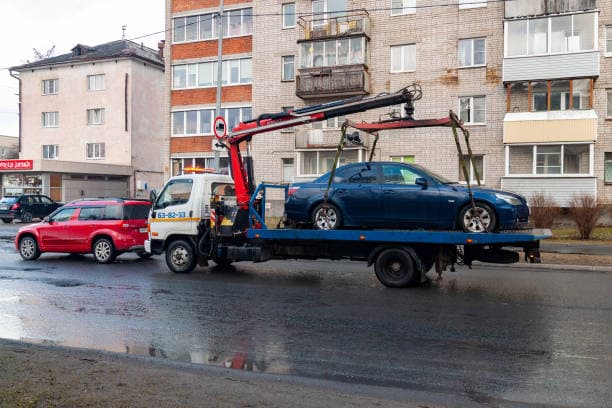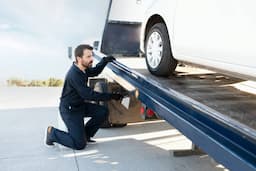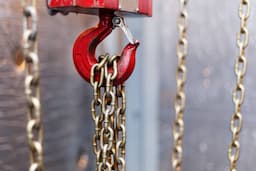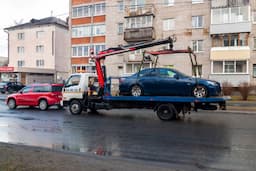When people think of tow trucks, the iconic image that often comes to mind is the hook-and-chain tow truck. These rugged machines have been an essential part of the towing industry for decades. Despite technological advancements leading to the development of newer tow truck designs, hook-and-chain tow trucks still hold historical significance and remain useful in certain situations today.
For vehicle enthusiasts, mechanics, and fleet operators like A1 A Auto and Truck, understanding the history, functionality, and modern-day relevance of these trucks provides valuable insight into the evolution of towing technology. This guide will cover everything you need to know about hook-and-chain tow trucks, from their origins to their advantages, disadvantages, and future prospects.
History of Hook-and-Chain Tow Trucks
The first tow truck ever built, back in 1916, was a hook-and-chain design. Invented by Ernest Holmes Sr. in Chattanooga, Tennessee, this innovation revolutionized vehicle recovery and roadside assistance. Early tow trucks needed rugged simplicity to pull vehicles from ditches, and the hook-and-chain system provided exactly that.
By looping a chain around a vehicle’s axle or frame, these trucks could lift one end of a vehicle off the ground and tow it away, even if the vehicle was heavily damaged. Over the decades, hook-and-chain trucks became symbols of the towing industry.
How Hook-and-Chain Tow Trucks Work
The basic design of a hook-and-chain tow truck revolves around three key components:
- Boom Arm: A large hydraulic or mechanical arm that extends from the rear of the truck.
- Heavy-Duty Hook: Attached to the end of the boom arm, the hook is used to grab onto the target vehicle.
- Chains: Thick steel chains secure the hook to the vehicle’s axle, frame, or another solid structural point.
Step-by-step Process
- The tow truck operator backs up to the vehicle being towed.
- Chains are looped around the front or rear axle of the vehicle.
- The hook connects the chains to the boom.
- Using hydraulics, the boom lifts the vehicle partially off the ground, allowing the non-lifted wheels to roll.
- The truck then tows the vehicle to the desired destination.
Advantages of Hook-and-Chain Tow Trucks
Even though they are considered somewhat outdated, hook-and-chain tow trucks offer several unique benefits:
1. Simplicity
- Fewer moving parts than modern flatbeds or wheel-lift tow trucks.
- Requires less specialized training for operators.
- Works effectively in rough terrains like dirt roads and off-road recovery.
2. Versatility
- Suitable for towing heavily damaged vehicles, including those involved in accidents.
- Effective for scrap car removal, where damage to the vehicle is irrelevant.
3. Lower Initial Cost
- Hook-and-chain trucks are typically cheaper to purchase compared to more modern options.
Disadvantages and Limitations
Despite their historical significance, hook-and-chain tow trucks have fallen out of favor for most modern towing needs. Here’s why:
1. Vehicle Damage
- Wrapping chains around axles, frames, or bumpers causes scratches, dents, and structural damage.
- Not suitable for towing newer vehicles, especially those with all-wheel drive or low clearance.
2. Legal and Regulatory Issues
- Many municipalities restrict the use of hook-and-chain trucks due to the potential for vehicle damage.
- Insurance companies often discourage or refuse to cover damage caused by these trucks.
3. Limited to Older or Junk Vehicles
- For modern roadside assistance involving drivable vehicles, wheel-lift and flatbed tow trucks are the preferred options.
- Hook-and-chain trucks are mostly used for junk cars, salvage yard recovery, or extreme off-road recoveries.
Modern Alternatives to Hook-and-Chain Tow Trucks
The decline of hook-and-chain trucks gave rise to:
1. Wheel-Lift Tow Trucks
- Instead of wrapping chains around the vehicle, a wheel-lift truck secures only the wheels.
- This minimizes damage to the body and frame.
2. Flatbed Tow Trucks
- Vehicles are fully loaded onto a flat platform, keeping all four wheels off the ground.
- Ideal for luxury cars, AWD vehicles, and low-clearance vehicles.
3. Integrated Tow Trucks
- Used for heavy-duty towing (buses, semis), these trucks combine wheel-lift and boom technologies.
When Are Hook-and-Chain Tow Trucks Still Used?
Although less common, hook-and-chain tow trucks still play a role in certain niches:
1. Towing Severely Damaged Vehicles
- In cases where the vehicle is already totaled, potential damage from the towing process is not a concern.
2. Off-Road and Extreme Recovery
- In rugged terrain, the simplicity and raw pulling power of hook-and-chain systems are still valued.
3. Junk Car Removal
- Scrap yards and salvage operations often use hook-and-chain trucks to drag non-operational vehicles onto flatbeds.
A1 A Auto and Truck: Embracing Tradition and Innovation
At A1 A Auto and Truck, we respect the legacy of hook-and-chain tow trucks while embracing modern technology. Understanding the evolution of towing allows us to offer the best solution for every customer, whether it’s a classic car that needs delicate transport or a severely damaged vehicle requiring rugged towing.
Our fleet includes flatbeds, wheel-lifts, and integrated trucks, ensuring we have the right equipment for every situation. That versatility is what makes A1 A Auto and Truck a trusted partner in the towing industry.
Safety Considerations for Hook-and-Chain Towing
If you still operate or encounter a hook-and-chain tow truck, here are important safety guidelines:
1. Inspect Chains and Hooks
- Ensure all components are free from rust, cracks, or excessive wear.
- Use chains with the appropriate weight rating for the vehicle being towed.
2. Secure the Load Properly
- Double-check that chains are tightened and will not loosen during transport.
- Avoid wrapping chains around cosmetic or weak parts of the vehicle.
3. Follow Local Laws
- Check for local towing regulations regarding the use of hook-and-chain trucks.
- Obtain proper permits for salvage and off-road recovery operations.
Environmental Impact and Future of Hook-and-Chain Trucks
In addition to the vehicle damage risks, hook-and-chain trucks are also less environmentally friendly. Many of these trucks are older diesel models with higher emissions compared to modern trucks.
However, there is some niche potential for hybrid or electric hook-and-chain designs, particularly for salvage yard work in urban areas where emissions regulations are strict. It’s also possible that innovative materials (like synthetic chains) could reduce the risk of vehicle damage.
Conclusion: Are Hook-and-Chain Tow Trucks Obsolete?
While not obsolete, hook-and-chain tow trucks are certainly specialized tools today. They no longer serve as the go-to solution for most roadside recoveries, but they still have a place in the towing world — particularly for salvage work, extreme recoveries, and historical interest.
For companies like A1 A Auto and Truck, understanding and respecting this history is crucial. It informs how we select equipment, train operators, and educate customers about their options. By blending tradition with innovation, we ensure every vehicle — from scrap heaps to showroom beauties — gets the right tow for the job.
About A1 A Auto and Truck
A1 A Auto and Truck is your trusted partner for towing, roadside assistance, and fleet services. With decades of experience, we pride ourselves on providing safe, efficient, and professional service across all towing technologies. Whether you need modern flatbed towing or specialty recovery using traditional methods, A1 A Auto and Truck has the expertise and equipment to get the job done right.
Meta Description:
A deep dive into hook-and-chain tow trucks—history, advantages, disadvantages, and their role at A1 A Auto and Truck.
Tagline:
Hook-and-Chain Tow Trucks: The Backbone of Classic Towing.
Need me to format this for your website’s CMS? Or add some SEO keywords tailored to your location?








